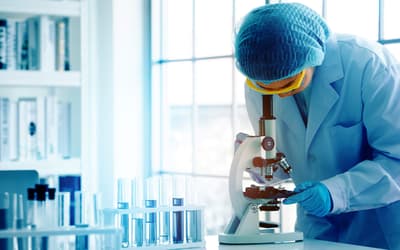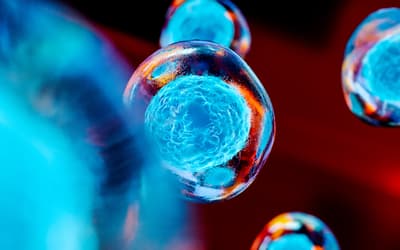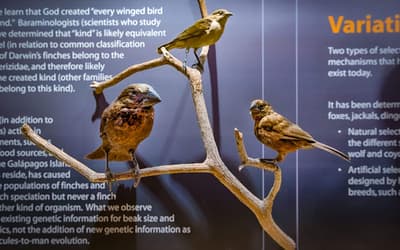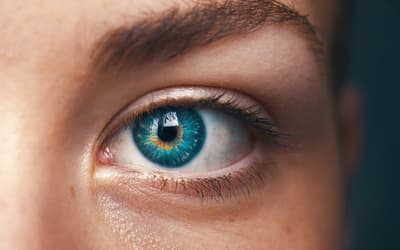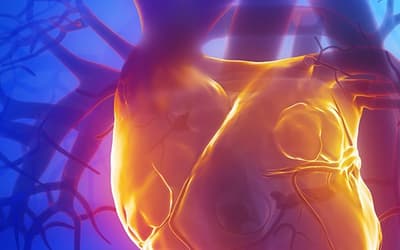The views expressed in this paper are those of the writer(s) and are not necessarily those of the ARJ Editor or Answers in Genesis.
Abstract
The history of the mutation theory as the foundation of the source of new genetic information is reviewed. The importance of mutations as the source of genetic change for evolution was thought to be so great that the 1946 Nobel Prize was presented to H. J. Muller for this discovery. Although still regarded as the bedrock of evolution, the experimental evidence has documented that significant genetic degeneration is caused by radiation. It is, consequently, not a significant source of the new variety that is critical to provide the variation necessary for Darwinian evolution to function. Falsifying the conclusion that mutations produce new genetic variety falsifies the core of evolution theory (Sniegowske, et al. 2000).
Keywords: mutations, genetic entropy, entropy, genetic variety, evolution, Nobel Prize, x-rays, radiation, cancer, birth defects, blunders in evolution.
Introduction
Skin, muscles, enzymes, hormones, and all organs are constructed primarily of protein. The genetic code used to produce protein is deoxyribonucleic acid (DNA). Evolution requires new genetic variety and natural selection to preserve the beneficial additions and helpful changes, and also eliminate the deleterious genetic changes. DNA both builds animal bodies and is the hereditary material that is passed on to future generations. Mutations are changes in the DNA code caused by mutagens, including carcinogens such as tobacco smoke, and radiation such as cosmic rays. In short, the raw material for natural selection is random mutations because it is the source of genetic variety that powers evolution. As acknowledged by one of the leading evolutionists of the last century, Theodosius Dobzhansky, the gene changes caused by mutagens, known as mutations, are the major source of evolutionary diversity (Sadava et al. 2006, 571). Sniegowske added “ mutation is the ultimate source of the genetic variation . . . mutations are accidents, and accidents will happen . . . Indeed, mutations are accidents” (Sniegowske, et al. 2000, 1064).
The Discovery of Mutations
When Darwin developed his theory of evolution, he was unable to propose a viable mechanism that produced genetic variety from which natural selection could select. The problem he faced was not survival of the fittest, but the arrival of the fittest. Around 1900, Dutch botanist Hugo de Vries (1848–1935) proposed that new species were not formed by slow changes that produced continuous variations in life as Darwin taught. Rather, they were caused by the sudden appearance of new genetic variations, an alteration he named “mutations”. Hugo de Vries also proposed that mutations are heritable and, therefore, are passed down to successive generations (de Vries 1909, 1910). His idea was eventually united with natural selection and formed the revised evolution theory called Neo-Darwinism, which is the term accepted today by most evolutionists.
Roentgen Discovers X-Rays
In 1895, German physics professor Wilhelm Roentgen discovered X-rays, a highly ionizing form of radiation that is most familiar to the public for its use in the medical field (fig. 1). Within months of the publication of Roentgen’s paper detailing his discovery, X-rays were beginning to be used for applications ranging from hospitals to shoe stores where they helped to determine how well shoes fit the customers’ feet (fig. 2) (Shapiro 1986).

Fig. 1. The X-ray of Professor Albert von Kölliker’s hand made by Röntgen on 23 January 1896. The first X-ray was of Röntgen‘s wife’s hand taken on 1st January 1896, only 23 days earlier. Image courtesy of Wikimedia Commons, Public domain.

Fig. 2. An X-ray machine used to check shoe fit. The two views are one for the customer and one for a parent or spouse. Image courtesy of Wikimedia Commons.
The American scientist Dr. Hermann Joseph Muller (1890–1967) knew that evolutionists believed “gene mutations formed the chief basis of organic evolution, and therefore of most complexities in living things” (Muller 1927). In the 1920s, Dr. Muller discovered that X-rays could increase the mutation rate in living organisms by as much as 100 times. He soon reasoned that he could drastically speed up evolution by artificially creating new mutations by X-rays. His experiments involved placing fruit flies in petri dishes, turning on his X-ray tube, then mating the flies that survived. Lastly, he attempted to measure and evaluate the number of mutations in the offspring (Muller 1927).
The excitement this discovery produced in the scientific community was so great that the Nobel Prize in Physiology was awarded to Muller in 1946 “for the discovery of the production of mutations by means of X-ray irradiation.” In his Nobel lecture Muller wrote:
Not only is this accumulation of many rare, mainly tiny changes the chief means of artificial animal and plant improvement, but it is, even more, the way in which natural evolution has occurred, under the guidance of natural selection. Thus the Darwinian theory becomes implemented, and freed from the accretions of directed variation and of Lamarckism that once encumbered it (Muller 1946, 162).
When Muller confirmed that mutations can deliberately be caused by X-rays, he formally proposed that they can be used to irradiate animals and plants to increase the evolution rate. In short, X-rays were an important means by which humans could, at will, change “the hereditary material” so “that evolution could then be speeded up” (Lönnig 2005, 47). His marrying natural selection with mutations produced the latest evolutionary theory called neo-Neo-Darwinism. This event illustrates the central importance of his mutation-causing discovery.
Using X-Rays to Speed Up Mutation Rates
A typical article that described the evolutionists’ excitement using Professor Muller’s experiments to speed up evolution documented the importance of mutations. The author concluded that evolutionary changes
can be produced 150 times as fast by the use of X-rays as they can by the ordinary processes of nature. This means that man may someday force the production of new and desirable plant and animal varieties far more rapidly than he has hitherto been able to. (Thone 1928, 235)
One headline tells it all: “New Discovery Speeds Up Evolution: Science Prize Winner Makes Discovery Believed by Many to Have Immense Practical and Scientific Significance” (Thone 1928, 235). Another headline enthusiastically proclaimed “Scientist Creates New Forms of Life: Dr. H. J. Muller Says Study of Mutations Shows Striking Changes are Possible. Works with Fruit Flies. U S Geneticist, Now in Russia, Produces Many Varieties of Insect With X-Rays” (The New York Times, March 29, 1936).
Muller: A Eugenicist
Muller (1936) also supported eugenics, (at least when he was younger), writing a book in support of the technique titled Out of the Night: A Biologist’s View of the Future. In this book, he described the use of mutations combined with eugenics could be used to create a superior race and a better future for mankind. Thone added that assisting or forcing nature so that new traits
will be produced faster than at the old rate, has for centuries been the breeder’s dream. Until recently, however, there was not even a hint of hope that this dream might be realized, because nobody knew what made mutations happen; nobody knew their mechanism. And until that was known, man lacked a handle to take hold of it in his effort to push nature along a bit. (Thone 1928, 235).
For his mutation research, Muller was awarded not only the Nobel Prize but also London’s prestigious Darwin-Wallace Medal in 1958, and the Kimber Genetics Award by the U.S. National Academy of Sciences in 1955. As an active atheist and anti-creationist, Muller also served as President of the American Humanist Association from 1956 to 1958 (Carlson 2011; Linskens 1982, 200).
Achieving the Breeder’s Dream Fails
Now that evolutionists knew how to cause mutations, they believed they could finally achieve the breeder’s dream. The X-ray dose that Muller exposed his test animals to was so intense that only 11% of the animals survived. These few survivors were then allowed to breed. When the first generation hatched from their eggs, Muller bred the second generation, then a third. He soon saw what he considered amazing results:
Mutations such as he had often seen in un-X-rayed stock turned up, together with a number of brand new ones. All told, he figures that he has produced at least 100 distinct gene mutations, genes being the carriers of hereditary qualities, and that the raying has speeded [sic] up the process over 15,000%. In the end, the rays will be applied to sheep and cattle, wheat and fruit (Thone 1928, 235).
In short, the solution to the goal of speeding up evolution was to artificially increase the rate of mutations. Muller reasoned that if
mutations always follow when accidents happen to the chromosomes in the course of nature, why not arrange a few such accidents, and thus get your desired hastening of the mutation process? Professor Muller decided to use heavy doses of X-rays. He chose the little flying creature we find on fruit when it begins to spoil, known variously as fruit-fly, vinegar-fly and pomace-fly. It has the advantage that it breeds very rapidly. (Thone 1928, 235)
Muller recognized the fact that mutations could be harmful, especially if high doses of radiation were used. Nonetheless, he felt that he could control the level to effectively evolve animals and plants, while avoiding most of the deleterious effects. This method, called mutation breeding, produced “an enormous euphoria . . . among biologists in general and geneticists and breeders in particular that the time had come to revolutionize the ‘old’ method of recombination breeding by the entirely new branch of mutation breeding” (Lönnig 2005, 48). Muller was optimistic about his discovery because he was convinced that what he called the “invisible mutations,” (those that cause minor non-lethal changes), “were the basis of the origin of all life-forms, including man” (Lönnig 2005, 48).
The Mutation Breeding Theory Is Discredited
Research soon confirmed the view held today, namely that mutations rarely produce beneficial changes (Sandford 2014). We now also recognize any method that causes DNA mutations commonly produces deleterious birth or developmental defects, and also diseases such as cancer (Gurley and Callaway 1992). For this reason, the use of X-ray machines in shoe stores is now banned, and even doctors recognize that a risk-benefit ratio exists for medical use of X-rays. The potential benefits must outweigh the risks before an X-ray is taken in a particular case. Muller also knew this, yet because mutations were the only known source of significant new genetic variety, he reasoned that mutations must be the source of the raw material for evolution (Muller 1927, 86–87).
The fact is that “although on very rare occasions a mutation can produce an improvement in a living thing, mutations are random changes unrelated to an animal’s needs except by chance” (Halacy 1966). Examples of a rare mutation that can produce a beneficial effect is a mutation in a dominant gene which allows a recessive gene to be expressed that confers to the organism a beneficial trait in certain limited circumstances (Behe 2019, 170–195). The question is, due to “contamination of the genome by very slightly deleterious mutations: why have we not died 100 times over?” (Kondrashov 1995). One reason why is humans have several mechanisms that repair the vast number of mutations that regularly occur in our genome (Bergman 2006). Exposure to mutagens caused problems because repair is not 100% accurate and eventually the body becomes swamped with mutations. A summary of the results of years of research speeding up the new mutations rate concluded that most mutational breeding programs “failed, especially in the early days of over optimism, to produce anything useful” (Simmonds 1979).
This finding of failure was not due to lack of effort to document their use. Of the thousands of tests, “only a very small fraction of induced mutants (certainly less than 1%) has ever been found suitable to enter yield trials and eventually only 1% of those evaluated passed the official tests and obtained approval for commercial utilization” (Micke 1976). To enter a yield trial the mutant must be promising enough to be formally researched in a large animal population. Those mutations that proved beneficial were usually because the mutation damaged a dominant gene, and thus allowed the recessive gene to be consistently expressed. The improvement is not because the mutation produced a new and better “more evolved” gene that improved the animal or plant.
Muller and others even tried to treat germ cells with “heavy doses of X-rays” to induce the occurrence of “true gene mutations” (Muller 1927). This process produced several hundred new mutant genes whose offspring were followed up for three or more generations. An analysis of the results concluded that lethal mutations “greatly outnumbered the non-lethals, producing a visible morphological abnormality,” a finding that was repeatedly found in other research (Muller 1927, 85).
The end of this line of research, as Professor Lönnig stresses, was that “according to all the evidence achieved so far by experimental investigations (and later also by careful considerations in theoretical genetics), there is absolutely no future for mutation breeding in animals—not to speak of severe ethical problems involved in the artificial mutagenesis of birds, mammals and other animals capable of feeling pain” (Dobzhansky 1941). Even in plant mutational breeding, the ratio of useful to useless mutations is estimated to be less than around 1 to 100,000 (Broertjes and Van Hartenvan 1978; Gottschalk and Wolff 1983).
Mutations Cause Disease
Given our present knowledge about ionizing radiation, Muller’s optimism and conclusions were grossly naïve, and actually dangerous. His theory was accepted for decades, largely because evolutionists had no other viable alternative method of producing new genetic variety. Machines in shoe stores that allowed costumers to use low dose X-rays to evaluate shoe fit were not banned in the Western world until the late 1960s.

Fig. 3. The hand of Clarence Dally a glass blower who tested his X-ray tubes on his hands. The photo was taken around 1900. Dally died after developing an aggressive from of cancer, which resulted in him having both of his hands, then his arms, amputated in an unsuccessful attempt to save his life. Shortly after his death, his boss, Thomas Edison abandoned his research on X-rays. It was well-known in the early 1900s that X-rays caused cancer and other problems. Image in public domain.
Nonetheless, clear indications existed in Muller’s day that radiation was harmful. One of the many examples involved Thomas Edison’s assistant Clarence Dally (fig. 3). Dally, after spending eight years helping to develop X-ray technology, lost his fingers, then his hand, next his arm below his elbow and finally his life from cancer in 1904 as a result of his X-ray exposure. After this, Edison refused to be involved in X-ray technology, even refusing to have an X-ray when he was ill.
Now we know that over 99% of mutations are near-neutral, mildly detrimental, or deleterious. Near-neutral means that they do not cause disease, but accumulate, causing aging and eventually causing disease. All carcinogens cause cancer by causing mutations that affect cell division regulation. Doctors have now identified over 5,000 genetic diseases, (such as sickle-cell anemia), caused by mutations. It is estimated that 10–20% of all pregnancies result in miscarriages, but the actual number is much higher. The reason is that many miscarriages are not formally classified as miscarriages because the loss occurs very early in the pregnancy, sometimes even before the women knows she is pregnant (Frost et al. 2007). The most common reason for a miscarriage by far is due to DNA damage, a problem indicating that human DNA is now enormously corrupt compared to the original creation (Goddijn and Leschot 2000; Qi, Hong at el. 2018).
Of side interest is a few organisms appear to thrive on radiation, such as the fungus Cryptococcus neoformans. This organism uses melanin, the pigment that gives humans their skin color, to obtain energy for growth (Dadachova and Casadevall 2008). This example is another illustration of the diversity of life. Researchers tested the response of three different species of fungus to gamma radiation given off from rhenium-188 and tungsten-188. The result was all three, Cladosporium sphaerospermum, Cryptococcus neoformans and Wangiella dermatitidis, grew faster in the presence of radiation (Ledford 2007).
Specifically, irradiated melanin increased its capacity to reduce a compound central to NADH (nicotinamide adenine dinucleotide) by a factor of four compared to non-irradiated melanin (Dadachova et al. 2007). NADH has a central role in the chemical process that generates useable energy in all life forms. This finding fits the fact that melanized microorganisms are commonly the dominant species in soils contaminated with radionuclides. Melanin in humans protects against both UV and solar radiation. By absorbing radiation and processing it safely to produce energy, fungi could possibly be used to protect humans, such as astronauts. Outer space lacks the magnetic field that protects humans on earth against harmful ionizing charged particle radiation, such as atom fragments, thus requires another protection system. The earth’s atmosphere effectively blocks short wavelength electromagnetic radiation, such as X-rays and gamma-rays.
Melanin helps explain the resistance of melanized fungi to ionizing radiation plus the fact that it can decompose certain radioactive materials (Mirchink, Kashkina, and Abaturov 1972; Saleh, Mayo, and Ahearn 1988). No evidence exists that the radiation causes mutations that help the organism survive.
The Mutation Rate in Humans
The mutation rate in humans is “at least one new mutation can be expected to occur in each round of cell division, even in cells with unimpaired DNA repair and in the absence of external mutagens. As a result, every child is born with an estimated 100 to 200 new mutations that were not present in the parents (Meisenberg and Simmons 2006, 153).
It was once believed that most of the mutations were in the so-called “junk” DNA that had no functions and, thusly, were believed harmless. However, it is now known that the vast majority of DNA has a function, and that this mutational load contributes to the degeneration of the genome, eventually causing genetic meltdown and extinction. In short, ‘evolution’ is true, but it is going backward. Both individuals and populations are devolving downward, not evolving upward as Darwinists claim, a process called genetic entropy (Sanford 2014). Mutations in individuals cause disease, such as cancer and all of the effects of aging.
Summary
Ironically, many Darwinists ignore the science and still assume that the major source of genetic variety from which natural selection can select is mutations (Bergman, 2021). In fact, it is still almost universally believed that “mutation is the ultimate source of new genetic variation within populations,” thus is the foundation of evolution (Wade 2005). Evolution requires a source of new genetic information, and without it evolution cannot occur (Bergman 2002).
In spite of over a century of effort, Darwinists have no better explanation for the source of new genetic variety. All of our attempts to “speed up evolution have not only failed, but in the end, have been unequivocally harmful. One author, writing contemporaneously with Muller, after claiming that we are the product of millions of years of evolution, wrote: “Until recently it was thought that our species had stopped evolving far in the past.” He then added that sophisticated complex modern high-tech X-ray technology has now allowed us to not only speed up but also to direct our own evolution (Max 2017).
Actually, this history of the attempts to further evolution by using radiation to produce mutations only documents the fact that mutations cannot be the source of the variety required to fuel evolution (Sanford 2014). Rather, mutations are a major cause of disease, including cancer and birth defects (Charlesworth 2012). Science has now been forced to invest in an enormous amount of research to ameliorate the results of disease caused by the accumulations of mutations that have occurred since Adam.
The use of X-rays to produce genetic variety was viewed by scientists as so significant that its discoverer was honored with the most coveted prize in science, the Nobel Prize.
References
Behe, Michael J. 2019. Darwin Devolves. The New Science About DNA that Challenges Evolution. New York, New York: Harper-One.
Bergman, Jerry. 2002. Why Mutations are Lethal to Darwinism.” Creation Research Society Quarterly, 38, no. 4 (March): 181–189.
Bergman, Jerry 2006. “The Elimination of Mutations by the Cell’s Elaborate Protein Quality Control Factory: A Major Problem for Neo-Darwinism” Creation Research Society Quarterly, 43, no. 2 (September): 68–74.
Bergman, Jerry. 2021. The Three Pillars of Evolution Demolished. Tulsa, Oklahoma: Bartlett Publishing (forthcoming).
Broertjes, C. and A. M. Van Hartenvan. 1978. Application of Mutation Breeding Methods in the Improvement of Vegetatively Propagated Crops. London, United Kingdom: Elsevier Science.
Carlson, Elof Axel. 2011. “Speaking Out About the Social Implications of Science: The Uneven Legacy of H. J. Muller.” Genetics 187 no. 1 (January): 1–7.
Charlesworth, Brian. 2012. “The Effects of Deleterious Mutations on Evolution at Linked Sites.” Genetics 190, no. 1 (January): 5–22.
Dadachova, Ekaterina, and Arturo Casadevall. 2008. “Ionizing Radiation: How Fungi Cope, Adapt, and Exploit With the Help of Melanin.” Current Opinion in Microbiology 11, no. 6 (December): 525–531.
Dadachova Ekaterina, Ruth A. Bryan, Xianchun Huang, Tiffany Moadel, Andrew D. Schweitzer, Philip Aisen, Joshua D. Nosanchuk, and Arturo Casadevall. 2007. “Ionizing Radiation Changes the Electronic Properties of Melanin and Enhances the Growth of Melanized Fungi.” PLoS One, May 23. doi:10.1371/journal.pone.0000457.
de Vries, Hugo. 1909. The Mutation Theory : Experiments and Observations on the Origin of Species in the Vegetable Kingdom. Vols. 1 and 2. Chicago, Illinois: The Open Court Publishing Company.
Dobzhansky, Theodosius. 1941. Genetics and the Origin of Species. New York, New York: Columbia University Press.
Frost, Julia, Harriet Bradley, Ruth Levitas, Lindsay Smith, and Jo Garcia. 2007. “The Loss of Possibility: Scientisation of Death and the Special Case of Early Miscarriage.” Sociology of Health and Illness 29, no. 7 (November): 1003–1022.
Goddijn, M. and N. Leschot. 2000. “Genetic Aspects of Miscarriage.” Best Practice and Research Clinical Obstetrics and Gynaecology 14, no. 5 (October): 855–865.
Gottschalk, W. and G. Wolff. 1983. Induced Mutations in Plant Breeding. New York, New York: Springer-Verlag.
Gurley, LaVerne Tolley, and William J. Callaway. 1992. Introduction to Radiologic Technology, Third Edition. St. Louis, Missouri: Mosby-Yearbook.
Halacy, Daniel. 1966. Radiation, Magnetism, and Living Things. New York, New York: Holiday House.
Kondrashov, Alexey S. 1995. “Contamination of the Genome By Very Slightly Deleterious Mutations: Why Have We Not Died 100 Times Over?” Journal of Theoretical Biology, 175, no. 4 (August): 583–594.
Ledford, Heidi. 2007. “Hungry Fungi Chomp on Radiation.” Nature, 23 May. doi:10.1038/news070521-5. https://www.nature.com/news/2007/070521/full/070521-5.html.
Linskens, H. F. 1982. “Review of Genes, Radiation and Society: The Life and Work of H. J. Muller by E. A. Carlson.” Theoretical Applied Genetics 63, no. 3 (September): 200.
Lönnig, Wolf-Ekkehard. 2005. “Mutation Breeding, Evolution, and the Law of Recurrent Variation.” Research Signpost 37/661, no. 2 (January): 45–70.
Max, D. T. 2017. “Beyond Human.” National Geographic 231, no. 4 (April): 40–63.
Meisenberg, Gerhard, and William H. Simmons. 2006. Principles of Medical Biochemistry. Philadelphia, Pennsylvania: Mosby.
Micke, A. 1976. “Induced Mutations in Cross-Breeding.” IAEA Panel Proceedings Series-International Atomic Energy Agency, 1–4. October 13–17. Wien, Vienna.
Mirchink, T. G., G. B. Kashkina, and Yu. D. Abaturov, 1972. “Resistance of Fungi With Different Pigments to Radiation.” Mikrobiologiia 41, no. 1: 83–86.
Muller, H. J. 1927. “Artificial Transmutation of the Gene.” Science 66 no. 1669 (July 22): 84–87.
Muller, H. J. 1936. Out of the Night: A Biologist’s View of the Future. New York, New York: Vanguard.
Muller, Hermann J. (1946) 1964. “The Production of Mutations”, Nobel Lecture—December 12, 1946. Reprinted in Nobel Lectures, Physiology or Medicine 1942–1962, 154–172. Amsterdam, Netherlands: Elsevier Publishing Company.
Qi, Hong, Zhao-Ling Xuan, Yang Du, Li-Rong Chai, Han Zhang, Xiao-Hui Wen, Xiang-Dong Kong, et al. 2018. “High Resolution Global Chromosomal Aberrations From Spontaneous Miscarriages Revealed By Low Coverage Whole Genome Sequencing.” European Journal of Obstetrics and Gynecology and Reproductive Biology 224 (May): 21–28.
Sanford, J. C. 2014. Genetic Entropy. 4th ed. Lansing, New York: FMS Publications.
Sadava, David E., H. Craig Heller, Gordon H. Orians, William K. Purves, and David M. Hillis. 2006. Life, Vol. II: Evolution, Diversity and Ecology. 8th ed. San Francisco, California: Freeman.
Saleh Y. G., M. S. Mayo, and D. G. Ahearn. 1988. “Resistance of Some Common Fungi to Gamma Irradiation.” Applied Environment Microbiology 54, no. 8 (August 1): 2134–2135.
Shapiro, Gilbert. 1986. A Skeleton in Darkroom: Stories of Serendipity in Science. San Francisco, California: Harper & Row.
Simmonds, Norman William. 1979. Principles of Crop Improvement. London, United Kingdom: Longman Publishing Group.
Sniegowski, Paul D., Philip J. Gerrish, Toby Johnson, and Aaron Shaver. 2000. “The Evolution of Mutation Rates: Separating Causes From Consequences.” BioEssays 22, no. 12 (December): 1057–1066.
Thone, Frank. 1928. “New Discovery Speeds Up Evolution: Science Prize Winner Makes Discovery Believed by Many to Have Immense Practical and Scientific Significance.” Scientific American 138, no. 3 (March): 235.
Wade, Michael. 2005. “Evolutionary Genetics.” Stanford Encyclopedia of Philosophy. https://plato.stanford.edu/entries/evolutionary-genetics/#pagetopright.

